Professional Ethics and Reflection in Early Childhood Education
VerifiedAdded on 2021/04/16
|6
|1404
|328
Essay
AI Summary
This essay delves into the critical aspects of professional ethics and reflective practice within the Early Childhood Education (ECEC) context. The author, drawing from personal experiences and established educational philosophies, articulates a teaching philosophy built on five core pillars: a high-quality, holistic learning curriculum; an inclusive learning environment; shared expectations and collaborative decision-making with families; connecting learning to real-world experiences; and providing supportive transitions. The essay emphasizes the importance of individualized learning, play-based activities, cultural sensitivity, and parent-teacher partnerships. It highlights practical examples, such as adapting teaching methods based on children's preferences and fostering cultural tolerance. The author also discusses strategies for smooth transitions for children entering and leaving the school environment. The essay concludes by underscoring the significance of the educator's vision of the child in shaping effective ECEC practices, thereby promoting holistic child development.
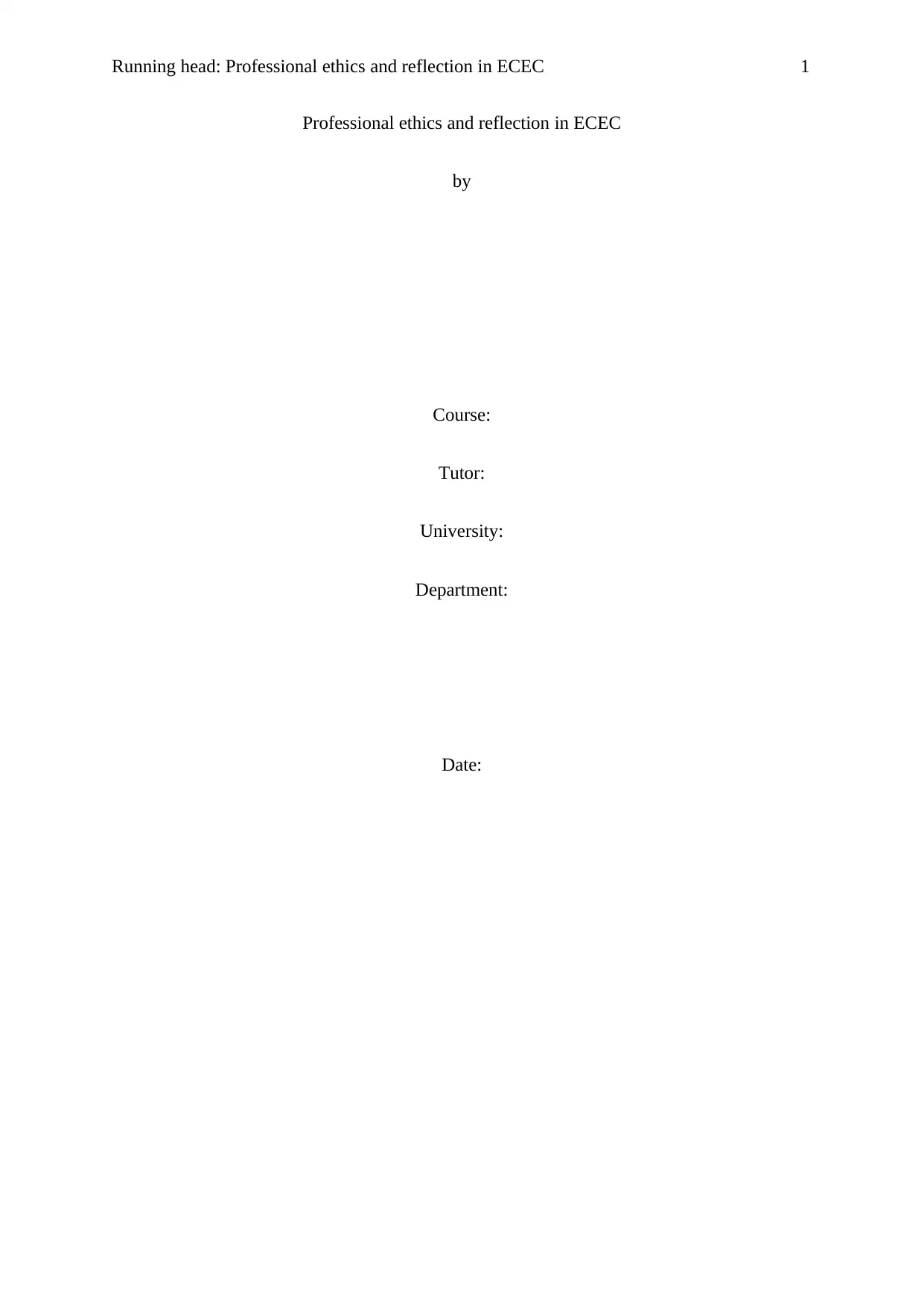
Running head: Professional ethics and reflection in ECEC 1
Professional ethics and reflection in ECEC
by
Course:
Tutor:
University:
Department:
Date:
Professional ethics and reflection in ECEC
by
Course:
Tutor:
University:
Department:
Date:
Paraphrase This Document
Need a fresh take? Get an instant paraphrase of this document with our AI Paraphraser
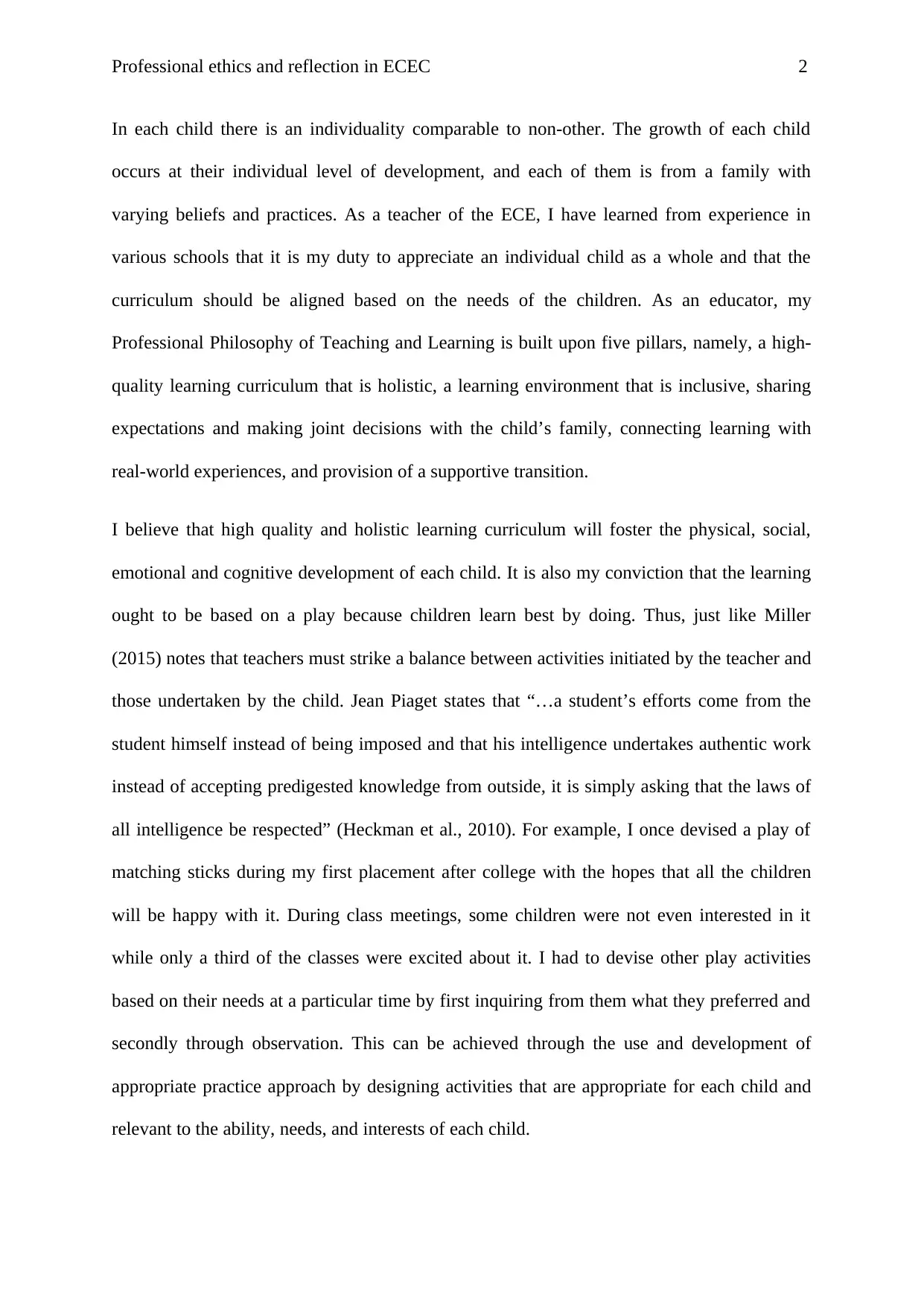
Professional ethics and reflection in ECEC 2
In each child there is an individuality comparable to non-other. The growth of each child
occurs at their individual level of development, and each of them is from a family with
varying beliefs and practices. As a teacher of the ECE, I have learned from experience in
various schools that it is my duty to appreciate an individual child as a whole and that the
curriculum should be aligned based on the needs of the children. As an educator, my
Professional Philosophy of Teaching and Learning is built upon five pillars, namely, a high-
quality learning curriculum that is holistic, a learning environment that is inclusive, sharing
expectations and making joint decisions with the child’s family, connecting learning with
real-world experiences, and provision of a supportive transition.
I believe that high quality and holistic learning curriculum will foster the physical, social,
emotional and cognitive development of each child. It is also my conviction that the learning
ought to be based on a play because children learn best by doing. Thus, just like Miller
(2015) notes that teachers must strike a balance between activities initiated by the teacher and
those undertaken by the child. Jean Piaget states that “…a student’s efforts come from the
student himself instead of being imposed and that his intelligence undertakes authentic work
instead of accepting predigested knowledge from outside, it is simply asking that the laws of
all intelligence be respected” (Heckman et al., 2010). For example, I once devised a play of
matching sticks during my first placement after college with the hopes that all the children
will be happy with it. During class meetings, some children were not even interested in it
while only a third of the classes were excited about it. I had to devise other play activities
based on their needs at a particular time by first inquiring from them what they preferred and
secondly through observation. This can be achieved through the use and development of
appropriate practice approach by designing activities that are appropriate for each child and
relevant to the ability, needs, and interests of each child.
In each child there is an individuality comparable to non-other. The growth of each child
occurs at their individual level of development, and each of them is from a family with
varying beliefs and practices. As a teacher of the ECE, I have learned from experience in
various schools that it is my duty to appreciate an individual child as a whole and that the
curriculum should be aligned based on the needs of the children. As an educator, my
Professional Philosophy of Teaching and Learning is built upon five pillars, namely, a high-
quality learning curriculum that is holistic, a learning environment that is inclusive, sharing
expectations and making joint decisions with the child’s family, connecting learning with
real-world experiences, and provision of a supportive transition.
I believe that high quality and holistic learning curriculum will foster the physical, social,
emotional and cognitive development of each child. It is also my conviction that the learning
ought to be based on a play because children learn best by doing. Thus, just like Miller
(2015) notes that teachers must strike a balance between activities initiated by the teacher and
those undertaken by the child. Jean Piaget states that “…a student’s efforts come from the
student himself instead of being imposed and that his intelligence undertakes authentic work
instead of accepting predigested knowledge from outside, it is simply asking that the laws of
all intelligence be respected” (Heckman et al., 2010). For example, I once devised a play of
matching sticks during my first placement after college with the hopes that all the children
will be happy with it. During class meetings, some children were not even interested in it
while only a third of the classes were excited about it. I had to devise other play activities
based on their needs at a particular time by first inquiring from them what they preferred and
secondly through observation. This can be achieved through the use and development of
appropriate practice approach by designing activities that are appropriate for each child and
relevant to the ability, needs, and interests of each child.
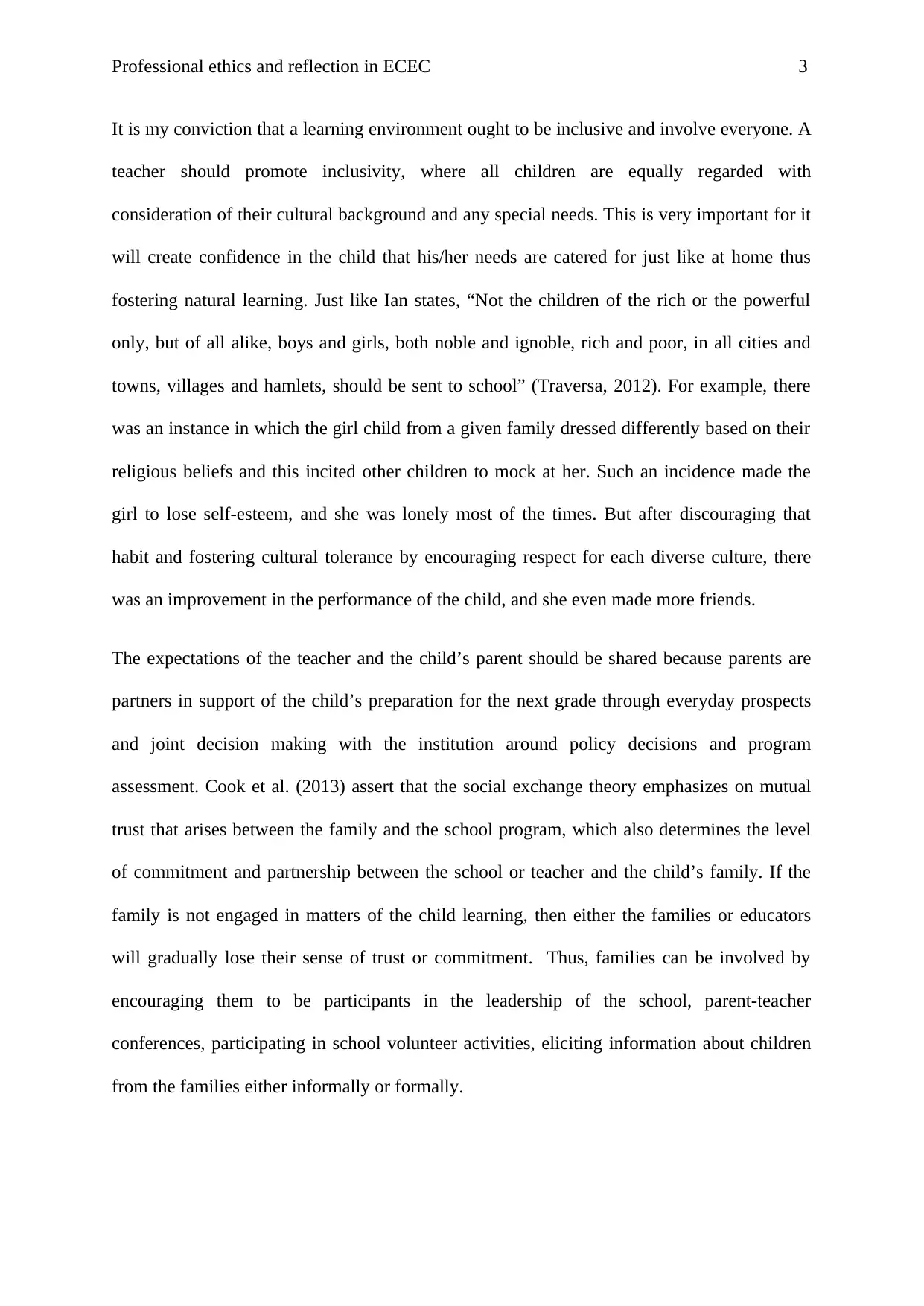
Professional ethics and reflection in ECEC 3
It is my conviction that a learning environment ought to be inclusive and involve everyone. A
teacher should promote inclusivity, where all children are equally regarded with
consideration of their cultural background and any special needs. This is very important for it
will create confidence in the child that his/her needs are catered for just like at home thus
fostering natural learning. Just like Ian states, “Not the children of the rich or the powerful
only, but of all alike, boys and girls, both noble and ignoble, rich and poor, in all cities and
towns, villages and hamlets, should be sent to school” (Traversa, 2012). For example, there
was an instance in which the girl child from a given family dressed differently based on their
religious beliefs and this incited other children to mock at her. Such an incidence made the
girl to lose self-esteem, and she was lonely most of the times. But after discouraging that
habit and fostering cultural tolerance by encouraging respect for each diverse culture, there
was an improvement in the performance of the child, and she even made more friends.
The expectations of the teacher and the child’s parent should be shared because parents are
partners in support of the child’s preparation for the next grade through everyday prospects
and joint decision making with the institution around policy decisions and program
assessment. Cook et al. (2013) assert that the social exchange theory emphasizes on mutual
trust that arises between the family and the school program, which also determines the level
of commitment and partnership between the school or teacher and the child’s family. If the
family is not engaged in matters of the child learning, then either the families or educators
will gradually lose their sense of trust or commitment. Thus, families can be involved by
encouraging them to be participants in the leadership of the school, parent-teacher
conferences, participating in school volunteer activities, eliciting information about children
from the families either informally or formally.
It is my conviction that a learning environment ought to be inclusive and involve everyone. A
teacher should promote inclusivity, where all children are equally regarded with
consideration of their cultural background and any special needs. This is very important for it
will create confidence in the child that his/her needs are catered for just like at home thus
fostering natural learning. Just like Ian states, “Not the children of the rich or the powerful
only, but of all alike, boys and girls, both noble and ignoble, rich and poor, in all cities and
towns, villages and hamlets, should be sent to school” (Traversa, 2012). For example, there
was an instance in which the girl child from a given family dressed differently based on their
religious beliefs and this incited other children to mock at her. Such an incidence made the
girl to lose self-esteem, and she was lonely most of the times. But after discouraging that
habit and fostering cultural tolerance by encouraging respect for each diverse culture, there
was an improvement in the performance of the child, and she even made more friends.
The expectations of the teacher and the child’s parent should be shared because parents are
partners in support of the child’s preparation for the next grade through everyday prospects
and joint decision making with the institution around policy decisions and program
assessment. Cook et al. (2013) assert that the social exchange theory emphasizes on mutual
trust that arises between the family and the school program, which also determines the level
of commitment and partnership between the school or teacher and the child’s family. If the
family is not engaged in matters of the child learning, then either the families or educators
will gradually lose their sense of trust or commitment. Thus, families can be involved by
encouraging them to be participants in the leadership of the school, parent-teacher
conferences, participating in school volunteer activities, eliciting information about children
from the families either informally or formally.
⊘ This is a preview!⊘
Do you want full access?
Subscribe today to unlock all pages.

Trusted by 1+ million students worldwide
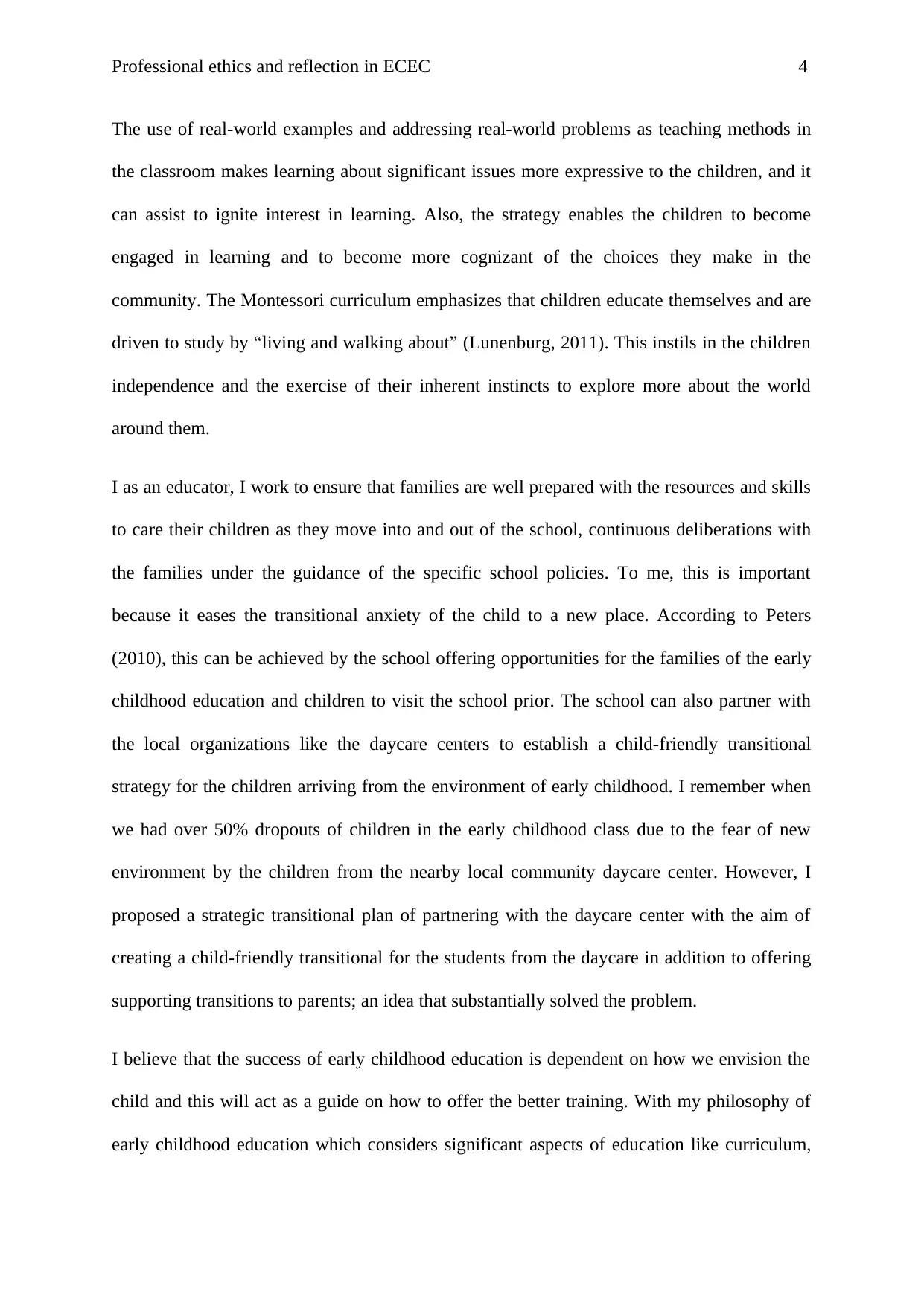
Professional ethics and reflection in ECEC 4
The use of real-world examples and addressing real-world problems as teaching methods in
the classroom makes learning about significant issues more expressive to the children, and it
can assist to ignite interest in learning. Also, the strategy enables the children to become
engaged in learning and to become more cognizant of the choices they make in the
community. The Montessori curriculum emphasizes that children educate themselves and are
driven to study by “living and walking about” (Lunenburg, 2011). This instils in the children
independence and the exercise of their inherent instincts to explore more about the world
around them.
I as an educator, I work to ensure that families are well prepared with the resources and skills
to care their children as they move into and out of the school, continuous deliberations with
the families under the guidance of the specific school policies. To me, this is important
because it eases the transitional anxiety of the child to a new place. According to Peters
(2010), this can be achieved by the school offering opportunities for the families of the early
childhood education and children to visit the school prior. The school can also partner with
the local organizations like the daycare centers to establish a child-friendly transitional
strategy for the children arriving from the environment of early childhood. I remember when
we had over 50% dropouts of children in the early childhood class due to the fear of new
environment by the children from the nearby local community daycare center. However, I
proposed a strategic transitional plan of partnering with the daycare center with the aim of
creating a child-friendly transitional for the students from the daycare in addition to offering
supporting transitions to parents; an idea that substantially solved the problem.
I believe that the success of early childhood education is dependent on how we envision the
child and this will act as a guide on how to offer the better training. With my philosophy of
early childhood education which considers significant aspects of education like curriculum,
The use of real-world examples and addressing real-world problems as teaching methods in
the classroom makes learning about significant issues more expressive to the children, and it
can assist to ignite interest in learning. Also, the strategy enables the children to become
engaged in learning and to become more cognizant of the choices they make in the
community. The Montessori curriculum emphasizes that children educate themselves and are
driven to study by “living and walking about” (Lunenburg, 2011). This instils in the children
independence and the exercise of their inherent instincts to explore more about the world
around them.
I as an educator, I work to ensure that families are well prepared with the resources and skills
to care their children as they move into and out of the school, continuous deliberations with
the families under the guidance of the specific school policies. To me, this is important
because it eases the transitional anxiety of the child to a new place. According to Peters
(2010), this can be achieved by the school offering opportunities for the families of the early
childhood education and children to visit the school prior. The school can also partner with
the local organizations like the daycare centers to establish a child-friendly transitional
strategy for the children arriving from the environment of early childhood. I remember when
we had over 50% dropouts of children in the early childhood class due to the fear of new
environment by the children from the nearby local community daycare center. However, I
proposed a strategic transitional plan of partnering with the daycare center with the aim of
creating a child-friendly transitional for the students from the daycare in addition to offering
supporting transitions to parents; an idea that substantially solved the problem.
I believe that the success of early childhood education is dependent on how we envision the
child and this will act as a guide on how to offer the better training. With my philosophy of
early childhood education which considers significant aspects of education like curriculum,
Paraphrase This Document
Need a fresh take? Get an instant paraphrase of this document with our AI Paraphraser
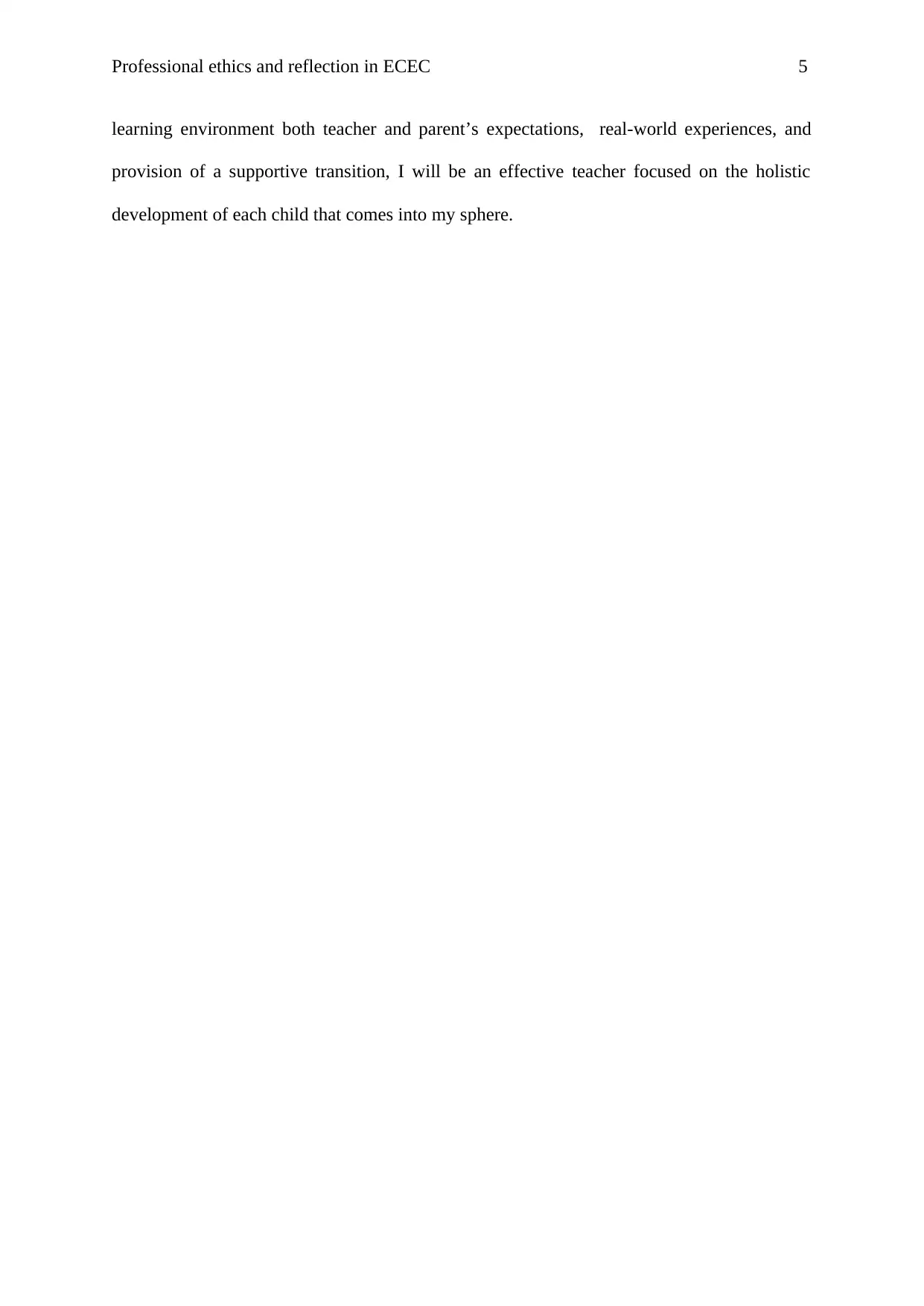
Professional ethics and reflection in ECEC 5
learning environment both teacher and parent’s expectations, real-world experiences, and
provision of a supportive transition, I will be an effective teacher focused on the holistic
development of each child that comes into my sphere.
learning environment both teacher and parent’s expectations, real-world experiences, and
provision of a supportive transition, I will be an effective teacher focused on the holistic
development of each child that comes into my sphere.
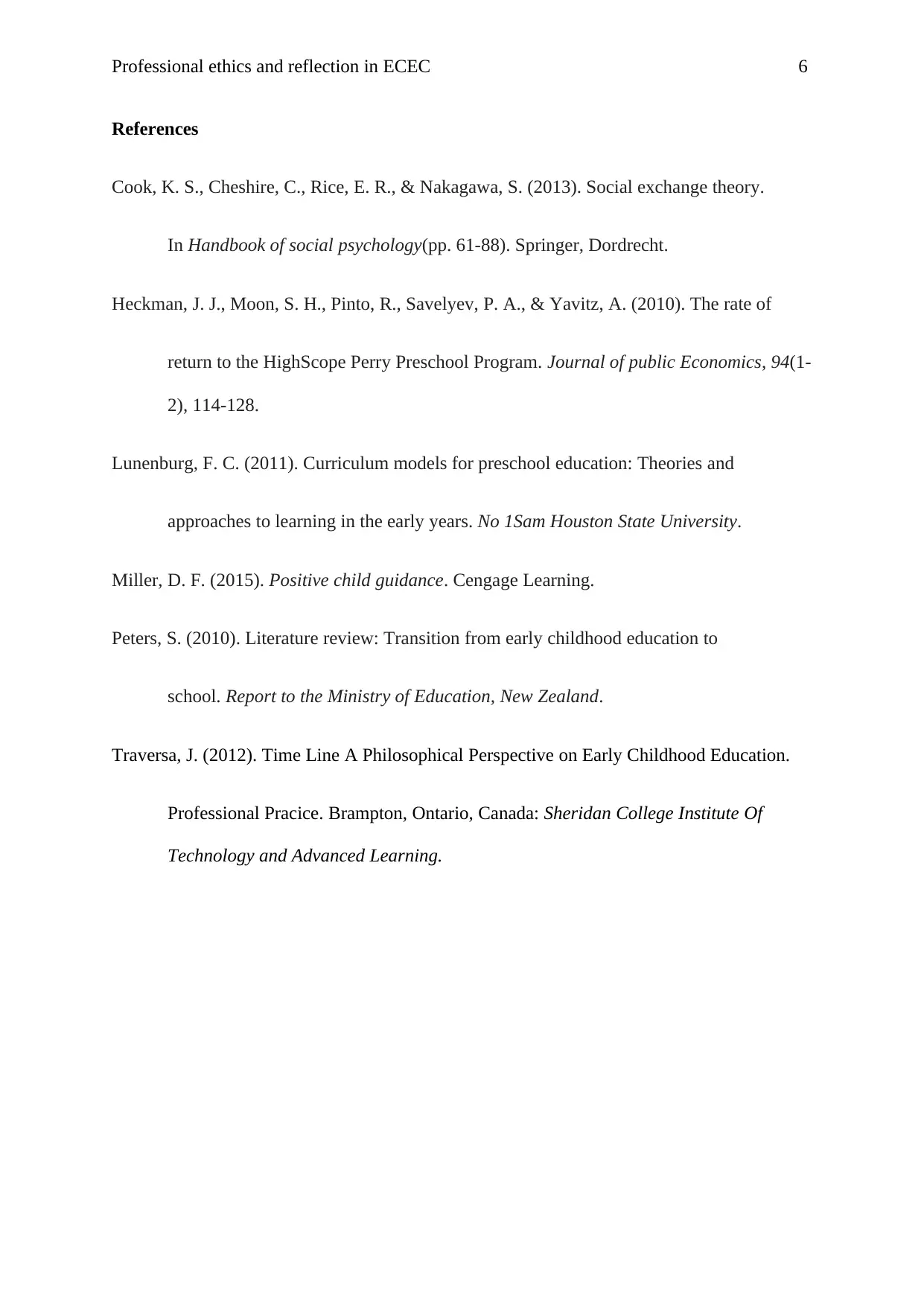
Professional ethics and reflection in ECEC 6
References
Cook, K. S., Cheshire, C., Rice, E. R., & Nakagawa, S. (2013). Social exchange theory.
In Handbook of social psychology(pp. 61-88). Springer, Dordrecht.
Heckman, J. J., Moon, S. H., Pinto, R., Savelyev, P. A., & Yavitz, A. (2010). The rate of
return to the HighScope Perry Preschool Program. Journal of public Economics, 94(1-
2), 114-128.
Lunenburg, F. C. (2011). Curriculum models for preschool education: Theories and
approaches to learning in the early years. No 1Sam Houston State University.
Miller, D. F. (2015). Positive child guidance. Cengage Learning.
Peters, S. (2010). Literature review: Transition from early childhood education to
school. Report to the Ministry of Education, New Zealand.
Traversa, J. (2012). Time Line A Philosophical Perspective on Early Childhood Education.
Professional Pracice. Brampton, Ontario, Canada: Sheridan College Institute Of
Technology and Advanced Learning.
References
Cook, K. S., Cheshire, C., Rice, E. R., & Nakagawa, S. (2013). Social exchange theory.
In Handbook of social psychology(pp. 61-88). Springer, Dordrecht.
Heckman, J. J., Moon, S. H., Pinto, R., Savelyev, P. A., & Yavitz, A. (2010). The rate of
return to the HighScope Perry Preschool Program. Journal of public Economics, 94(1-
2), 114-128.
Lunenburg, F. C. (2011). Curriculum models for preschool education: Theories and
approaches to learning in the early years. No 1Sam Houston State University.
Miller, D. F. (2015). Positive child guidance. Cengage Learning.
Peters, S. (2010). Literature review: Transition from early childhood education to
school. Report to the Ministry of Education, New Zealand.
Traversa, J. (2012). Time Line A Philosophical Perspective on Early Childhood Education.
Professional Pracice. Brampton, Ontario, Canada: Sheridan College Institute Of
Technology and Advanced Learning.
⊘ This is a preview!⊘
Do you want full access?
Subscribe today to unlock all pages.

Trusted by 1+ million students worldwide
1 out of 6
Related Documents
Your All-in-One AI-Powered Toolkit for Academic Success.
+13062052269
info@desklib.com
Available 24*7 on WhatsApp / Email
![[object Object]](/_next/static/media/star-bottom.7253800d.svg)
Unlock your academic potential
Copyright © 2020–2025 A2Z Services. All Rights Reserved. Developed and managed by ZUCOL.




